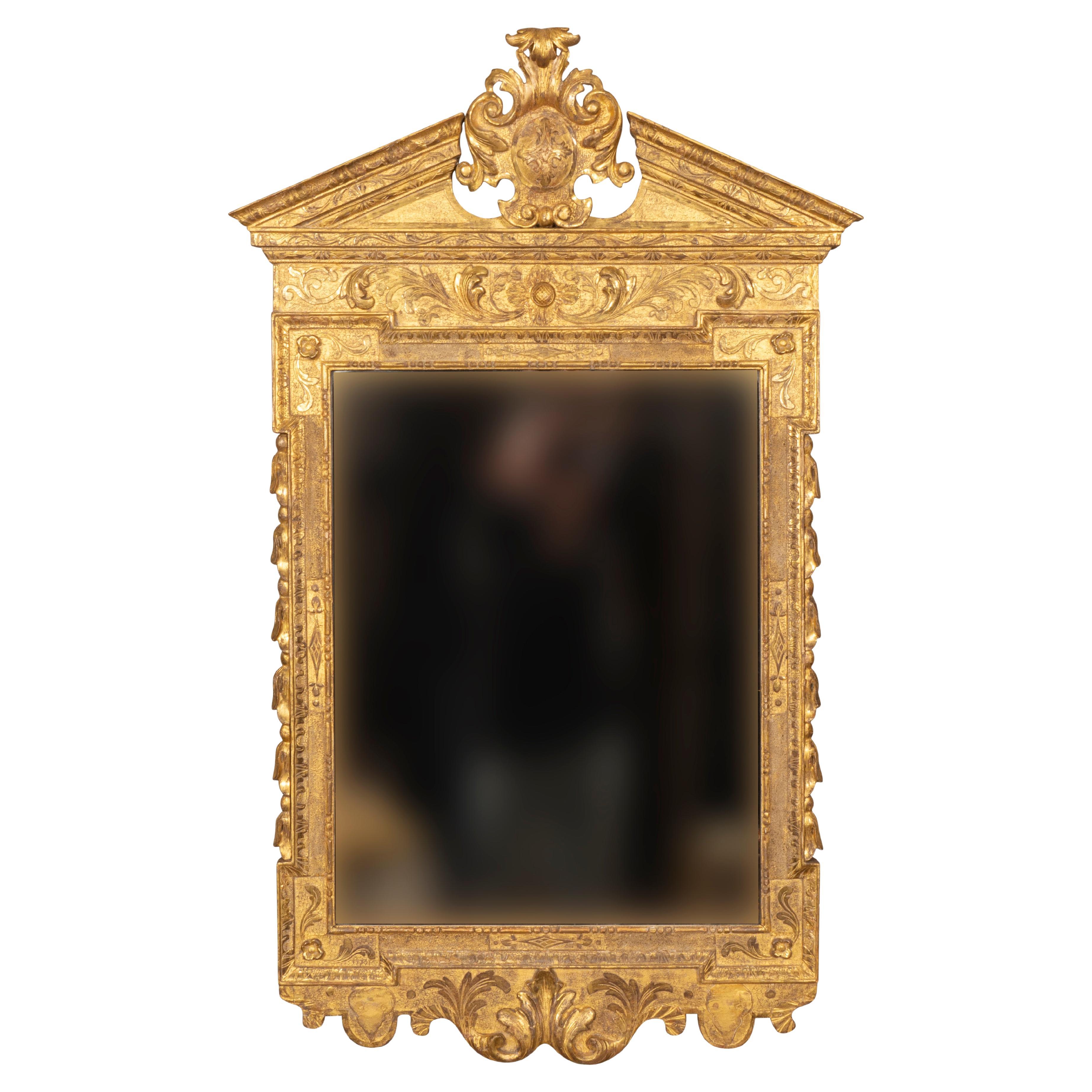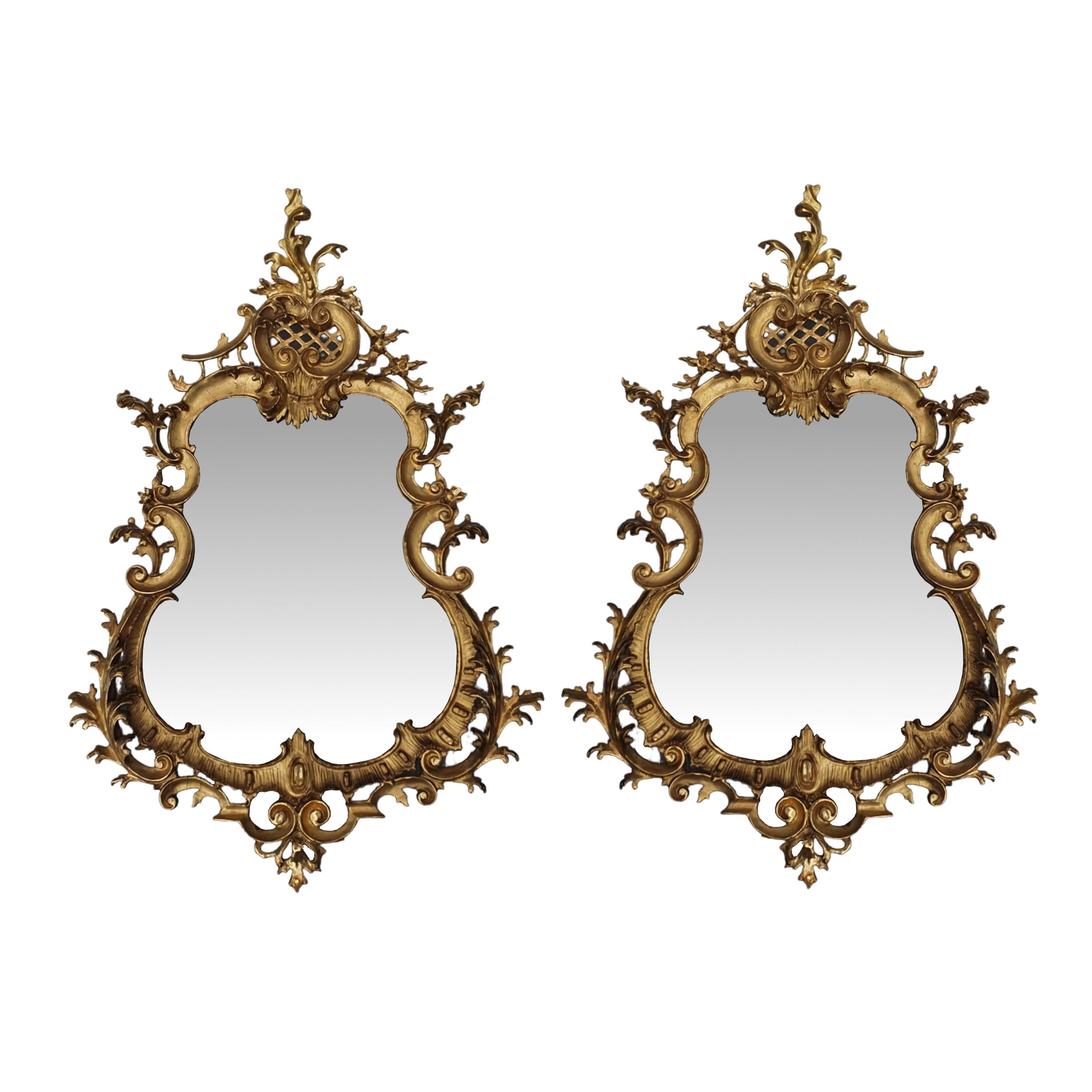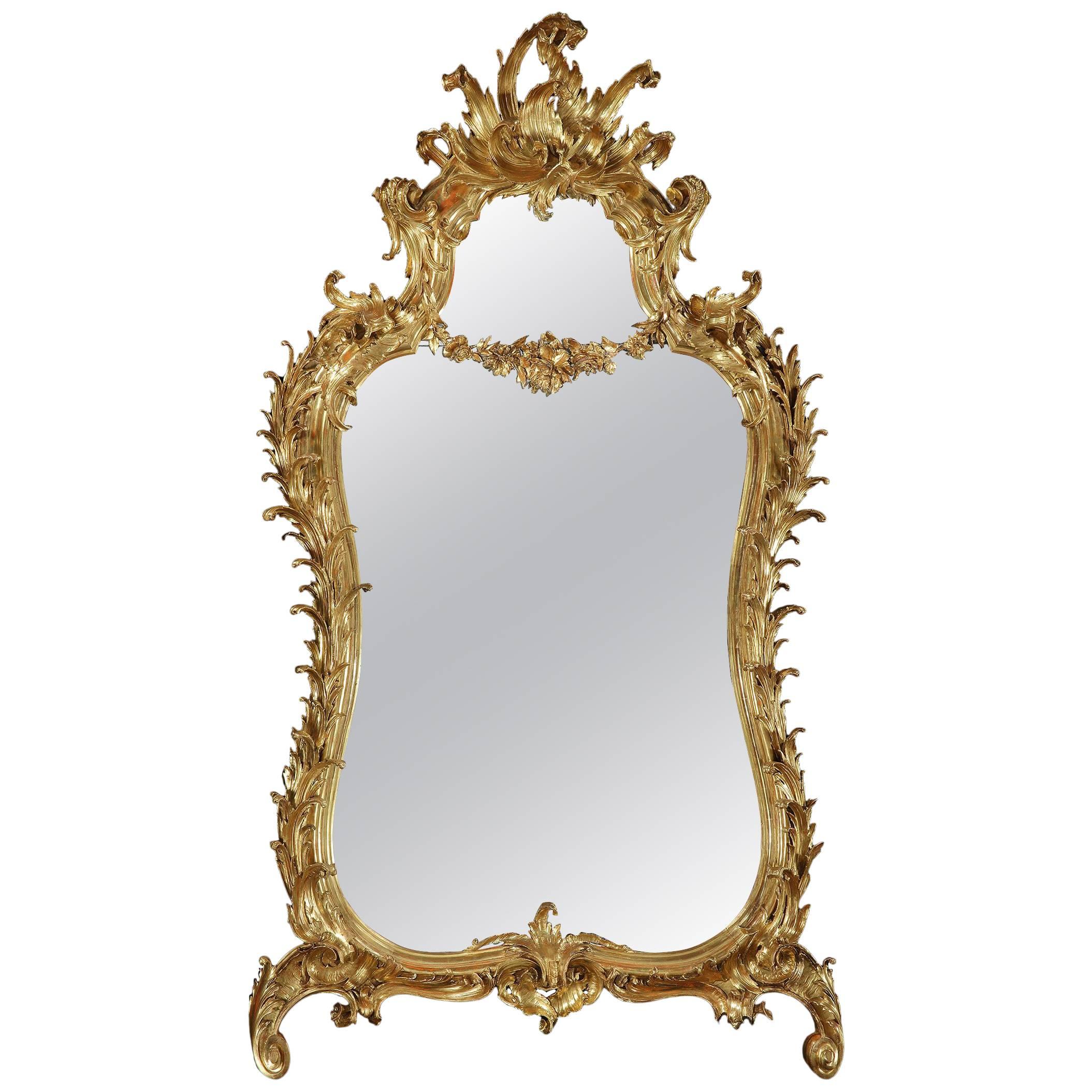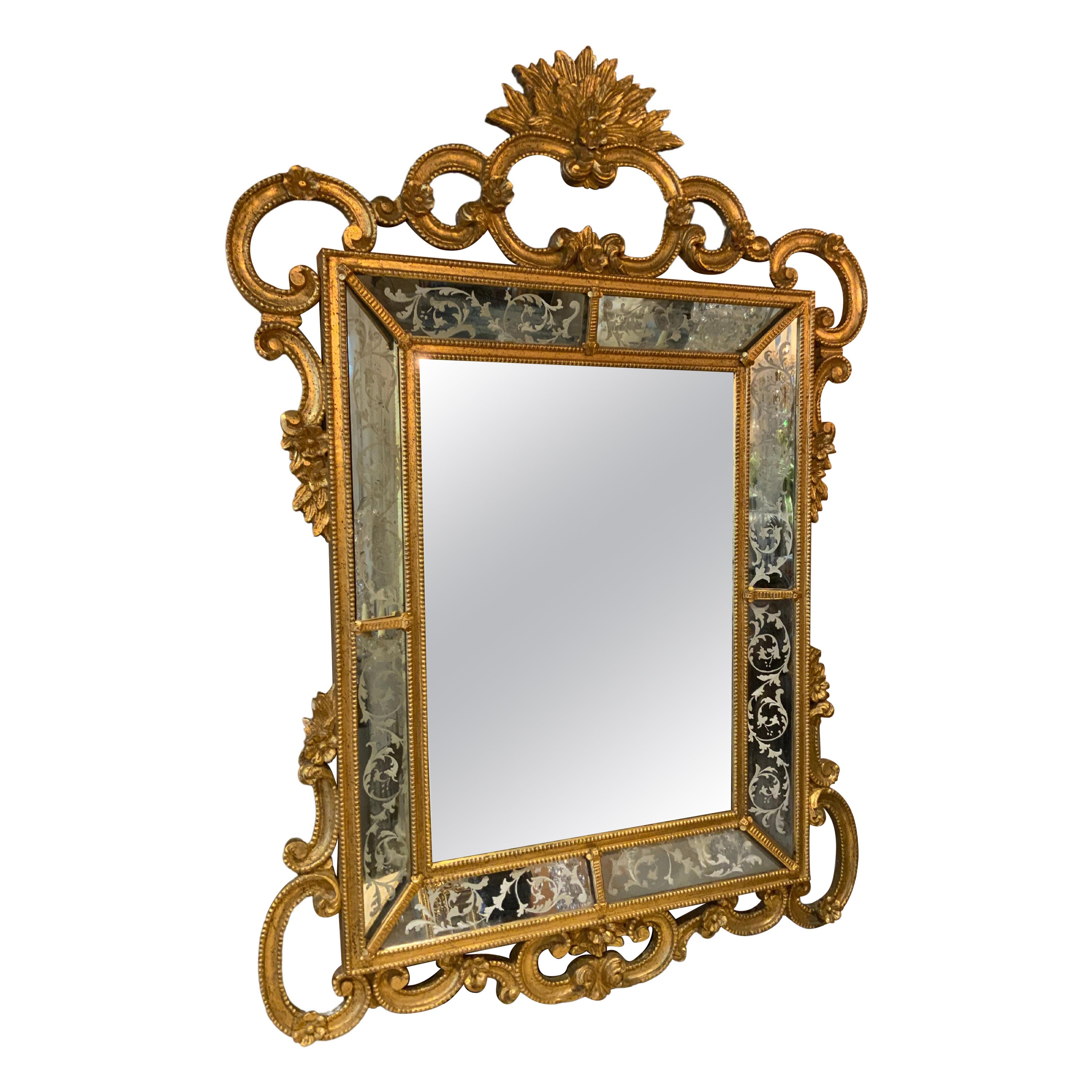Items Similar to Early English Giltwood Rococo Mirror C.1760 in the Manner of John and William Li
Want more images or videos?
Request additional images or videos from the seller
1 of 9
Early English Giltwood Rococo Mirror C.1760 in the Manner of John and William Li
About the Item
A Very Fine and Early English Giltwood Rococo Mirror with Carved with Fronds and Green Bullrushes very much in the manner of John and William Linnell.
English Circa 1760
Provenance
Percy Cook, trading as A. Cook Antiques, 12-16 St Christopher's Place off of Wigmore Street in Marylebone, London (dealer label on the backboard of the frame)
At some stage the mirror has passed through the workshops of the famous restorers and gilders W. Thomas Ltd. as their label is stuck to the inside of the backboard. W. Thomas worked extensively with Partridge Fine Arts of Bond Street, one of the most venerable of all antique dealers, but also worked with other fine dealers and private clients. As can be seen their gilt work is of the highest quality and finish.
The mirror is of broadly rectangular outline with a beautiful later mercury plate, of fine colour and with little deteoriation to the mirrored surface. The frame has a rocaille cresting, the sweeping branches which frame it giving it something of a pagoda form. This is mirrored in a stylised anthemion to the base, and the sides are ornamented with very finely carved reeds of particularly naturalistic execution. A very rare feature are the green coloured bull rushes to be found in two places amongst the fronds on each side.
The use of palm fronds in English interiors of the 18th century perhaps reached its zenith in John Vardy's famous palm room designed for Spencer House in St James, London. Designed in 1757, the room is one of the most astonishing interiors created in this period and was very influential in its effect on the taste of connoisseurs of the time.
Amongst the surviving Linnell drawings in the collections of the Victoria and Albert Museum are several mirror designs which incorporate fronds and have a similar feeling to our piece. Oval mirrors in frames of carved fronds are known to have been a speciality of the firm (see Helena Hayward and Patricia Kirkham John and William Linnell: Eighteenth Century Furniture Makers Vol. 2 fig. 196 p.102 for an illustration of this popular design) and it is extremely possible, given the delicacy of its excecution and the fine quality of its design, that our piece was also made by this important London workshop based in Berkeley Square.
Width: 26 1/2 inches - 67cm
Height: 44 1/2 inches - 114cm
Depth: 6 1/2 inches - 16cm
- Dimensions:Height: 44.5 in (113.03 cm)Width: 26.5 in (67.31 cm)Depth: 6.5 in (16.51 cm)
- Style:Rococo (Of the Period)
- Materials and Techniques:
- Place of Origin:
- Period:1760-1769
- Date of Manufacture:C1760
- Condition:Wear consistent with age and use.
- Seller Location:Benington, GB
- Reference Number:
About the Seller
5.0
Gold Seller
These expertly vetted sellers are highly rated and consistently exceed customer expectations.
Established in 1969
1stDibs seller since 2015
112 sales on 1stDibs
Typical response time: <1 hour
Associations
LAPADA - The Association of Arts & Antiques DealersThe British Antique Dealers' Association
- ShippingRetrieving quote...Ships From: Benington, United Kingdom
- Return PolicyA return for this item may be initiated within 3 days of delivery.
More From This SellerView All
- Rare Pair of Spanish Colonial 18th Century Tortoiseshell Enconchado Mirrors, PerLocated in Benington, HertsA Rare and Unusual Pair of 18th Century Spanish Colonial 'Enconchado' Mirrors Veneered in Tortoiseshell and Inlaid With Bone and Mother of Pearl Made in Lima (Peru) or Mexico Circa 1720 Provenance One of the mirrors with a fragmentary label printed with "Bodmer", possibly relating to one of the branches of the Bodmer family in Switzerland, some of whom were renowned collectors of South American art The mirrors of rectangular form with ripple moulded outer borders framing tortoishell veneered inner borders inlaid with fine bone stringing and sinuous floral motifs inlaid in mother of pearl. The sight edges also veneered and inlaid with a repeating geometric motif. The mirrors are notable for the fine quality of the inlay, their unusually large size for this date, in particular the size of the plates themselves (possibly original) and the fact that they are a pair. The term 'Enconchado' comes from Spanish colonial art, particularly associated with Mexico, comprising of oil paintings inlaid with mother of pearl and other iridescent minerals. This form of art is discussed in great detail by Miguel Arisa in his essay Luminosity in Mexican Enconchado Paintings and Conceptions of the Sacred in Visual Culture and Indigenous Agency in the Early Americas, The Early Americas: History and Culture, Volume: 10 Chapter 4 (October 2021). He argues that the development of this style was an attempt to combine pre-Hispanic indigenous South American traditions regarding the sacred properties of "shiny objects" and "Baroque concepts of the miraculous", the sparkling inlay adding to the power of the European religious imagery. Mirrors such as the present pair are likewise cross-cultural objects, fusing European form and aesthetic concerns with indigenous craftsmanship to create objects of great prestige and decorative appeal. The ripple mouldings are clearly the result of a 17th century Dutch...Category
Antique 1720s Mexican Wall Mirrors
MaterialsTortoise Shell
- Important Regency Mahogany Partners Writing Table in the Manner of George SmithBy George Smith, Charles NormanLocated in Benington, HertsA highly Important, Early Regency period mahogany, ebonised and parcel-gilt partners writing table on monopodia legs of exceptional quality and design, in the manner of George Smith, stamped Chas Norman, whom was associated with the work of Gillows. Labelled ‘Morning Room’. English, Regency period, circa 1810. Rarely seen, the crescent shaped ended rectangular top, beautifully lined with the original gilt tooled leather writing surface, enclosed by a mahogany cross-banded border and reeded edge. The frieze, containing four finely chosen fiddle-back mahogany drawers, two pairs to opposing sides, each retaining the original gadrooned carved ebonised knob handles. The perimeters having a finely ebonised cockbead, whilst the drawer liners being executed in mahogany retain the original recessed brass locks, which look to have never been removed. Flanking the drawers are bead-moulded ebonised panels which conform to either end above a reeded mould. Raised on four boldly designed and imposing, crisply carved, ebonised and parcel-gilt leopard monopodia supports, of wonderful original waxed condition. The Egyptian leopards mask above a bold breast decorated with carved gilt anthemion and guilloche motifs, finishing on a finely detailed carved leg and paw foot. The condition is excellent, retaining the original hand-dyed and gilt tooled waxed leather writing surface along with original locks, handles and ebonising with gilt-work to the legs. Commissioned for what presumes to be a private collection and due to its condition, being obvious to see, this writing table has been home to an important household. Labelled ‘Morning Library’ to the underside, whilst in this exemplary condition strongly suggests this striking piece of Regency furniture has furnished the library of the said house for the majority of its life. As can be noted, this is an extremely rare, elegant, early Regency writing table of exceptional colour, which corresponds with designs of the celebrated furniture maker and designer George Smith, workmanship of Gillows, being stamped to the underside Chas Norman four times. George Smith (1756 - 1826) was one of the most influential furniture designers of the English Regency Period (1811-1830). Smith, who began his pattern-book in 1804, wrote of ‘the great taste and elegance’ of this design. In 1808 he published his influential and definitive text on Regency interior Design titled ‘ A Collection of Designs for Household Furniture and Interior Decoration’ and classed himself as ‘Upholder Extraordinary to His Royal Excellency the Prince of Wales’…The Prince Regent. Smith was inspired in his designs from his earlier career as an Egyptologist, producing drawings incorporating motifs of Leopards heads and paws, Lions, sphinx’s, anthemia, and griffons amongst others. Charles Heathcote Tatham (1772-1842) published ‘Etchings, Representing the Best Examples of Ancient Ornamental Architecture; Drawn from the Originals in Rome, and Other Parts of Italy During the Years 1794, 1795, and 1796’, in which he illustrated an antique tripod table...Category
Antique 1810s British Regency Desks and Writing Tables
MaterialsMahogany, Giltwood
- Mid-century Walnut Sideboard Enfilade 1960 in the Manner of Vladimir KaganBy Vladimir KaganLocated in Benington, HertsAn Unusual and Rare Mid 20th Century Walnut Sideboard / Enfilade with pyramid doors and drawers. Probably USA - Circa 1960 Of rectangular form with fo...Category
Vintage 1960s American Mid-Century Modern Sideboards
MaterialsWalnut
- Fine William Iv Birdseye Maple and Carver Giltwood Library or Centre TableLocated in Benington, HertsAn Elegant William IV Birdseye Maple and Carver Giltwood Library / Centre or Sofa Table English Circa 1830 This distinctive library or centre table of birdseye maple and carved g...Category
Antique 1830s English William IV Center Tables
MaterialsBirdseye Maple
- Pair of 18th Century Venetian Giltwood Wall SconcesLocated in Benington, HertsA very decorative and impressive pair of Italian Venetian giltwood wall sconces late 18th Century. Italian circa 1780. The two leaf carved up-scrolled candlebranches issuing fr...Category
Antique 1780s Italian Rococo Wall Lights and Sconces
MaterialsGiltwood
- Mid 18th Century Italian Rococo Armchair in Walnut With Extravagantly CarvedLocated in Benington, HertsMid 18th Century Italian Rococo Armchair in Walnut with Extravagantly Carved Head Rail Italian Circa 1760 This beautiful armchair is executed in walnut and, in its basic form, is h...Category
Antique Mid-18th Century Italian Rococo Armchairs
MaterialsWalnut
You May Also Like
- George II Giltwood Mirror in the Manner of William KentLocated in Essex, MAWith perfectly burnished surface with wonderful gilt accents with broken arch pediment with central cartouche over a mirror plate set in a conforming frame with bead and reel and aca...Category
Antique 1730s English George II Wall Mirrors
MaterialsGiltwood
- Rare Pair of 19th Century Pier Giltwood Mirrors in the Rococo MannerLocated in Dublin, IERare pair of 19th century pier giltwood mirrors in the rococo manner. An exceptional pair of pier mirrors, the shaped mirror plate is set within a...Category
Antique 19th Century Irish Pier Mirrors and Console Mirrors
MaterialsGlass, Giltwood
- Rococo Giltwood MirrorBy La BargeLocated in North Hollywood, CARococo antique gold leaf mirror attributed to La Barge Italy.Category
Antique 17th Century Italian Rococo Wall Mirrors
MaterialsWood
- Giltwood Mirror in the Manner of Thomas ChippendaleBy Thomas ChippendaleLocated in London, GBWith an elaborately caved gold leaf framed with free scrolling lappet branches in the rococo style, the base with inverted cabriole legs and a central shell and leaf cartouche, the p...Category
Antique 19th Century English George III Wall Mirrors
MaterialsGiltwood
- Giltwood Mirror in the Venetian Rococo Taste with EtchingLocated in Houston, TXThis piece is carved in the Venetian rococo taste with curved and Scrolling frames with foliate detail. It has double framing with inset Mirror that has hand etching...Category
Mid-20th Century Italian Rococo Wall Mirrors
MaterialsGiltwood
- George I Mirror in the Manner of John BelchierLocated in Greenwich, CTVery fine George I carved and gilt mirror, circa 1720, in the manner of John Belchier having an ostrich feather plume over tasseled central lambrequin, d...Category
Antique Early 18th Century English George I Wall Mirrors
MaterialsGiltwood
Recently Viewed
View AllMore Ways To Browse
Uso Interno
John Salibello Mirror
Brass Mirror Scroll
Heart Shaped Wall Mirror
Grace Mirror
Painted Carved Mirror
Midcentury Brass Italian Mirror Rectangular
Vintage Mid Century Oval Wall Mirror
Clean Gilt Mirror
Pair Of Oval Frame Mirrors
Midcentury Brass Mirror Rectangular
Black Painted Wood Mirror
Wegner Mirror
Italian Wall Mirror Brass Mirror Glass Italy 1940s
Octagonal Murano
Horizontal Louis Mirror
Large Italian Smoked Glass Mirror
Small Bathroom Wall Mirror





